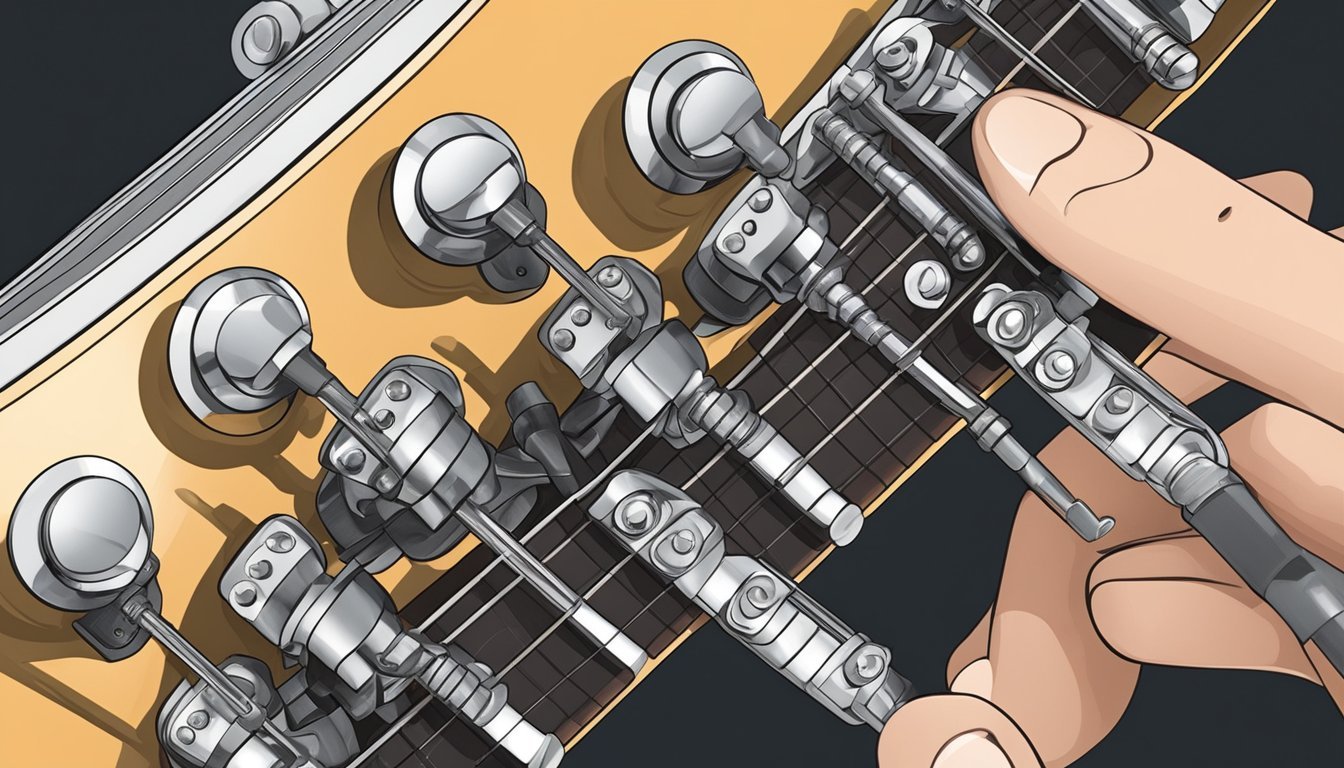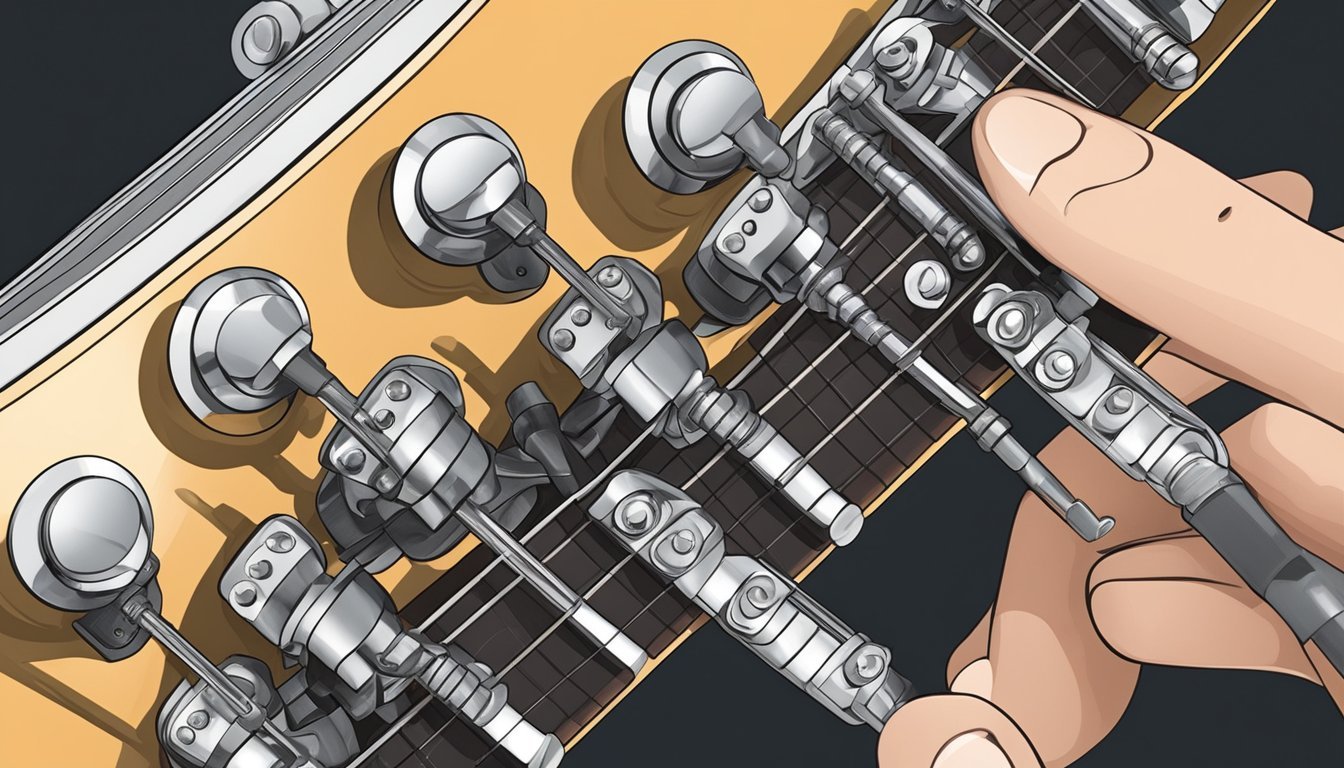Tuning your guitar is essential for playing songs correctly and sounding great.
Most guitars use standard tuning, which includes the notes E, A, D, G, B, and e from the lowest to the highest string.
Knowing this will help you get started on the right foot.

Whether you’re a beginner or have been playing for a while, understanding how to tune your guitar can make a big difference in your music.
You can use various tools and methods, from electronic tuners to tuning apps, to help you achieve the perfect sound.
As you dive deeper into guitar playing, you might explore different tuning techniques and alternate tunings to add uniqueness to your music.
Each tuning can bring a new flavor to your songs, so experimenting is definitely worth it.
Tuning Basics
When tuning your guitar, it’s important to understand how the standard tuning works, what the strings are, and how tuning pegs adjust the sound.
Let’s break this down.
Understanding Standard Tuning
In standard tuning, a guitar’s six strings are tuned to specific notes.
Starting from the thickest string to the thinnest, they are:
- E (6th string)
- A (5th string)
- D (4th string)
- G (3rd string)
- B (2nd string)
- e (1st string)
This tuning is often written as EADGBE.
It makes playing chords and scales easier for beginners and helps you sound good right away.
Knowing this tuning helps in learning songs as it’s the most common setup for guitarists.
Identifying the Strings and Their Notes
To get the right sounds from your guitar, you need to know the string names and their corresponding notes.
- E string: the thickest string, important for low tones.
- A string: creates a warm sound that’s very versatile.
- D string: adds richness and is key in many chords.
- G string: brings brightness, often found in melodies.
- B string: vital for creating harmonious chords.
- e string: the thinnest string, perfect for high notes and leads.
When tuning, start from the low E string and work your way up.
Make sure each string rings true to its note.
Explanation of Tuning Pegs and Machine Heads
The tuning pegs, also known as machine heads, are found on the headstock of your guitar.
They control the tension of each string, which changes the pitch.
- To raise the pitch: turn the peg counterclockwise to tighten the string.
- To lower the pitch: turn the peg clockwise to loosen it.
Adjusting these pegs allows you to fine-tune your guitar.
If a string sounds too flat or sharp, twist the corresponding peg to fix the sound.
Regular tuning will help keep your guitar sounding its best and make playing more enjoyable.
Tuning Tools and Methods
There are various tools and methods you can use to tune your guitar.
Some are high-tech, while others are simple and traditional.
Below is a breakdown of the most effective options to help you get your guitar sounding just right.
Electronic Tuners and How They Work
Electronic tuners are popular because they make tuning straightforward.
These devices, like chromatic tuners, detect the pitch of your strings.
When you pluck a string, the tuner shows whether it is too high or low.
It usually has a display with a needle or light that helps you know what to adjust.
Most tuners work for electric guitars and acoustic guitars.
Many models also have different tuning modes, allowing you to select standard or alternative tunings.
This is handy for experimenting with different sounds.
Clip-On Tuners Versus Smartphone Apps
Clip-on tuners are convenient tools that attach to the headstock of your guitar.
They pick up vibrations and display the tuning status.
This makes them useful in noisy environments, where sound-based tuners may struggle.
On the other hand, smartphone apps offer similar functionality without the need for extra gear.
They can also include extra features like tuning forks and instructional guides.
Some popular apps even create a tuner that’s as accurate as a professional device.
While both options are effective, clip-on tuners are often more reliable in loud settings, while smartphone apps provide added versatility.
Tuning by Ear for the Musically Inclined
If you have a good ear, tuning by ear can be very satisfying.
This method involves using reference points like a tuning fork or another instrument.
You can match the pitch of your strings to ensure they sound right.
One common technique is to start by tuning the low E string to a reference pitch, then use the 5th fret method to tune the other strings.
For example, the 5th fret of the low E string is the same note as the open A string.
This method is great for developing your musical ear.
It might take a little practice, but it’s rewarding once you get the hang of it.
Using a Fretboard and Tuning Notes
Utilizing the fretboard can also help you tune your guitar.
You can use specific tuning notes to guide you.
In standard tuning, the strings are tuned to E, A, D, G, B, and e.
To get started, play the 5th fret on the low E string, which is A. Tune the open A string to match that note.
Next, repeat this for the next strings using their corresponding frets.
For example, the 5th fret of the A string is D, which you can use to tune the D string.
This method helps you learn the fretboard better while you tune.
Tuning Techniques for Different Guitar Types
When tuning your guitar, it’s important to consider the type you’re using.
Acoustic and electric guitars have distinct tuning techniques that can affect sound quality and playability.
Different approaches can help you get the most out of your instrument.
Acoustic Versus Electric: Adjusting Your Approach
Acoustic guitars rely on natural sound projection.
Tuning them often uses a standard method using an electronic tuner, but you can also use your ear.
Start by tuning the sixth string to E and then tune the others relative to it.
For electric guitars, you might want to use a pedal tuner for precision.
Electric guitars can also be more sensitive to temperature changes.
This means you might need to check the tuning more often.
Fine-Tuning an Electric Guitar for Precision
Fine-tuning an electric guitar involves a few extra steps.
After you’ve initially tuned your guitar, play some chords or notes.
If something sounds off, it might be time to make minor adjustments.
Using the nut and bridge adjustments can improve tuning stability.
Many electric guitars come equipped with locking tuners for added precision.
This helps keep your guitar in tune, especially during bends and heavy strumming sessions.
Don’t forget to check your intonation.
This ensures that your guitar plays in tune across the neck.
With the right tuning process, your electric guitar will sound its best.
Advanced Tuning: Alternate Tunings and Tips
If you want to explore new sounds on your guitar, alternate tunings are a great way to unlock creativity.
You can shift your playing style, find new chords, and enhance your overall sound.
Here are some popular options and tips to get you started.
Exploring Open Tunings and When to Use Them
Open tunings are a fun way to create different chords with minimal finger movement.
In this tuning style, you adjust the strings so that strumming without pressing down makes a chord.
Some common types include Open D (D-A-D-F#-A-D) and Open A (E-A-E-A-C#-E).
These tunings are especially popular in folk and blues music.
You can easily find songs using these tunings, such as “Big Yellow Taxi” by Joni Mitchell.
Try using open tunings when you want a richer, ringing sound or if you want to experiment with slide guitar techniques.
Drop D Tuning for Heavier Music Genres
Drop D tuning is an effective choice for rock and heavy metal.
To set this tuning, lower your low E string to D: D-A-D-G-B-e. This setup produces a deeper sound and makes it easier to play power chords.
You’ll love how simple it is to create heavy riffs with this tuning.
It allows you to use open strings for added resonance.
Bands like Nirvana and Tool frequently use Drop D, making it a staple in heavier genres.
Experimenting with C Standard and Other Variants
C Standard tuning (C-G-C-F-A-D) is another alternate tuning that gives you a lot more depth in your sound.
This tuning lowers each string a whole step from standard tuning, making it easier to press down on frets while providing a heavier tone.
Many guitarists love C Standard for its range, especially for metal.
It can also make certain chord shapes easier to play.
Don’t hesitate to try this tuning, as it might inspire your songwriting or lead to new ideas.
Maintaining Concert Pitch and Intonation
When shifting to alternate tunings, it’s important to maintain concert pitch.
Concert pitch is the standard tuning reference for most music.
Use a tuner to ensure your guitar is in tune with other instruments, especially if you play with a band.
Regularly check your intonation by adjusting the guitar’s bridge.
This keeps your guitar sounding good across its fretboard, ensuring notes sound in tune no matter where you play.
Keep these tips in mind as you explore new tunings, and have fun experimenting!
Frequently Asked Questions
Tuning your guitar can feel tricky at first, but it gets easier with practice.
Here are some common questions that can help guide you in tuning your guitar effectively.
How do I tune my guitar for the first time?
Tuning your guitar for the first time can be daunting, but it’s not too hard once you get the hang of it.
Start by getting familiar with the notes of each string.
You can use a tuner or an app to help you get the right pitch.
The standard tuning is E2, A2, D3, G3, B3, and E4 from the lowest string to the highest.
Once you’re comfortable with the standard tuning notes, practice plucking each string and adjusting it until it matches the pitch.
There are also various online resources and videos that can demonstrate how to tune a guitar effectively.
Remember, with a little patience and practice, you’ll be able to tune your guitar with confidence and enjoy making music!
Can you show me how to tune a guitar using a tuner?
Using a tuner is straightforward.
Simply plug in the guitar or use the mic on the tuner.
Play each string one at a time.
The tuner will show you if the string is too high, too low, or just right.
Adjust the tension of the string until the tuner indicates it’s in tune.
What’s the deal with standard guitar tuning?
Standard guitar tuning is the most popular way to tune a guitar.
It is commonly known as EADGBE.
This tuning allows you to play a wide variety of music and is great for beginners to learn chords and scales easily.
Any tips on tuning a guitar without any tools?
You can tune your guitar by matching the pitch of one string to another.
For instance, you can press the fifth fret of the low E string and match it to the open A string.
Use the same technique for all strings, comparing them to the others to get in tune.
Is there a trick to tuning a guitar by ear?
Tuning by ear requires practice, but it’s a great skill to have.
Start by learning the sound of each string when it’s in tune.
Use a reference pitch, like a piano note or an app, and match each string to that note.
It helps if you can hear the difference between being flat or sharp.
Where can I find a guitar tuner online?
You can find many online guitar tuners with a simple search.
Websites often have interactive tuners that work with your device’s mic.
There are also apps available for smartphones that can serve as reliable tuners.
This makes it easy to tune anywhere you go.

